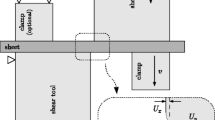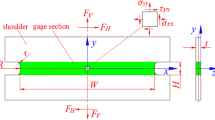Abstract
A hybrid experimental-computational procedure to establish accurate true stress-plastic strain curve of sheet metal specimen covering the large plastic strain region using shear compression test data is described. A new shear compression jig assembly with a machined gage slot inclined at 35° to the horizontal plane of the assembly is designed and fabricated. The novel design of the shear compression jig assembly fulfills the requirement to maintain a uniform volume of yielded material with characteristic maximum plastic strain level across the gage region of the Shear Compression Metal Sheet (SCMS) specimen. The approach relies on a one-to-one correlation between measured global load–displacement response of the shear compression jig assembly with SCMS specimen to the local stress-plastic strain behavior of the material. Such correlations have been demonstrated using finite element (FE) simulation of the shear compression test. Coefficients of the proposed correlations and their dependency on relative plastic modulus were determined. The procedure has been established for materials with relative plastic modulus in the range 5 × 10−4 < (E p /E) < 0.01. It can be readily extended to materials with relative plastic modulus values beyond the range considered in this study. Nonlinear characteristic hardening of the material could be established through piecewise linear consideration of the measured load–displacement curve. Validity of the procedure is established by close comparison of measured and FE-predicted load–displacement curve when the provisional hardening curve is employed as input material data in the simulation. The procedure has successfully been demonstrated in establishing the true stress-plastic strain curve of a demonstrator 0.0627C steel SCMS specimen to a plastic strain level of 49.2 pct.














Similar content being viewed by others
References
Rice JR, Tracey DM (1969) On the ductile enlargement of voids in triaxial stress fields. J Mech Phys Solids 17(3):201–217
Choung JM, Cho SR (2008) Study on true stress correction from tensile tests. J Mech Sci Technol 22(6):1039–1051
Ling Y (1996) Uniaxial true stress–strain after necking. AMP J Technol 5:37–48
Zhang ZL, Hauge M, Ødegård J, Thaulow C (1999) Determining material true stress–strain curve from tensile specimens with rectangular cross-section. Int J Solids Struct 36(23):3497–3516
Joun M, Choi I, Eom J, Lee M (2007) Finite element analysis of tensile testing with emphasis on necking. Comput Mater Sci 41(1):63–69
Johnson GR, Cook WH (1983) A constitutive model and data for metals subjected to large strains, high strain rates and high temperatures. Proc 7th International Symposium on Ballistics. The Hague, Netherlands: International Ballistics Committee
Bodner SR, Partom Y (1975) Constitutive equations for elastic-viscoplastic strain-hardening materials. Trans ASME J Appl Mech 42:385–389
Anand L (1985) Constitutive equations for hot-working of metals. Int J Plast 1(3):213–231
Rusinek A, Klepaczko JR (2001) Shear testing of a sheet steel at wide range of strain rates and a constitutive relation with strain-rate and temperature dependence of the flow stress. Int J Plast 17(1):87–115
Lee W-S, Liu C-Y (2006) The effects of temperature and strain rate on the dynamic flow behaviour of different steels. Mater Sci Eng, A 426(1):101–113
Brar NS, Joshi VS, Harris BW (2007) Constitutive model constants for low carbon steels from tension and torsion data. Proc 15th APS Topical Conference on Shock Compression of Condensed Matter. Hawaii: APS
Hooputra HH, Gese HD, Werner H (2004) A comprehensive failure model for crashworthiness simulation of aluminum extrusions. Int J Crashworthiness 9(5):449–463
Ishiguro TY, Yoshida NY, Ishikawa T (2009) Deformation analysis of shearing process using results of notched round bar tension test. Mater Trans 50(7):1671–1677
Oh CS, Kim NH, Kim YJ, Baek JH, Kim YP, Kim WS (2011) A finite element ductile failure simulation method using stress-modified fracture strain model. Eng Fract Mech 78(1):124–137
Borhana AA, Mohamad AT, Abdul-Latif A, Ahmad Z, Ayob A, Tamin MN (2012) Ductile failure prediction of spot welded lap joint. Appl Mech Mater 165:285–289
(2000) ASTM, Standard test method for uniaxial tension test, ASTM-E8. Philadelphia, PA
(2009) BSI, British Standard Institution BS EN ISO 6892-1, Metallic materials-Tensile testing. London
(2000) ASTM, Standard test methods for compression testing of metallic materials at room temperature, ASTM E9-89a. West Conshohocken, PA
(2011) BSI, British Standard Institution BS ISO 13314, Mechanical testing of metals. Ductility testing. Compression test for porous and cellular metals. London
Bao Y (2003) Prediction of ductile crack formation in uncracked bodies. Dissertation, Department of Ocean Engineering, Massachusetts Institute of Technology
Dorogoy A, Karp B, Rittel D (2011) A shear compression disk specimen with controlled stress triaxiality under quasi-static loading. Exp Mech 51:1545–1557
Dorogoy A, Karp B, Rittel D (2013) A shear compression disk specimen with controlled stress triaxiality under dynamic loading. Exp Mech 53(2):243–253
Balakrishnan V (1999) Measurement of in-plane Bauschinger effect in metal sheets. Dissertation, Ohio State University
Bae GH, Huh H (2011) Cyclic tension/compression test of auto-body steel sheets with the variation of the strain rate. In: IDDRG, Bilbao, Spain
Merklein M, Kuppert A (2009) A method for the layer compression test considering the anisotropic material behavior. Int J Mater Form 2:483–486
Rittel D, Lee S, Ravichandran G (2002) A shear-compression specimen for large strain testing. Exp Mech 42(1):58–64
Vural M, Rittel D, Ravichandran G (2003) Large strain mechanical behavior of 1018 cold-rolled steel over a wide range of strain rates. Metall Mater Trans A Phys Metall Mater Sci 34A(12):2873–2885
Rittel D, Ravichandran G, Lee S (2002) Large strain constitutive behavior of OFHC copper over a wide range of strain rates using the shear compression specimen. Mech Mater 34(10):627–642
Vural M, Molinari A, Bhattacharyya N (2011) Analysis of slot orientation in shear-compression specimen (SCS). Exp Mech 51(3):263–273
Dorogoy A, Rittel D (2005) Numerical validation of the shear compression specimen. Part 1: quasi-static large strain testing. Exp Mech 45(2):167–177
Dorogoy A, Rittel D (2006) A numerical study of the applicability of the shear compression specimen to parabolic hardening materials. Exp Mech 46(3):355–366
Kalidindi SR, Abusafieh A, ElDanaf E (1997) Accurate characterization of machine compliance for simple compression testing. Exp Mech 37(2):210–215
Lovato ML, Stout MG (1992) Compression testing techniques to determine the stress/strain behavior of metals subject to finite deformation. Metall Trans A 23(A):935–951
Acknowledgments
This work is supported by the Ministry of Science, Technology and Innovation (MOSTI), Malaysia through Technofund Research Grant No. 79909 and by Sebha University, Libya through UTM Grant No. 73746.
Author information
Authors and Affiliations
Corresponding author
Rights and permissions
About this article
Cite this article
Borhana, A., Ali, H.O. & Tamin, M.N. Large Strain Shear Compression Test of Sheet Metal Specimens. Exp Mech 53, 1449–1460 (2013). https://doi.org/10.1007/s11340-013-9763-0
Received:
Accepted:
Published:
Issue Date:
DOI: https://doi.org/10.1007/s11340-013-9763-0






